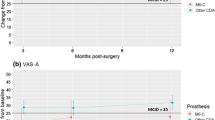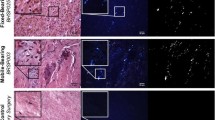Abstract
This report describes a case of one-level total disc replacement (TDR) of L5-S1 requiring revision at 9.5 years following the index surgery due to polyethylene failure caused by high oxidation. Primary revision strategies for TDR include instrumented posterolateral fusion, or 360° fusion with replacement of the prosthesis with cages or allograft bone. A revision of a TDR with a similar prosthesis has not been described in the literature. An active 42-year-old female underwent TDR with a Charité artificial disc. She remained active and pain free for 9.5 years before presenting with moderate low-back pain and sciatica. Radiographic studies confirmed a fragmented polyethylene core. The failed prosthesis was revised to a new Charité disc with the patient again active and pain free for 6 months following surgery. Chemical and physical analysis of the core indicated high oxidation due to gamma sterilization in air; a process changed to gamma sterilization in nitrogen in 1998 to meet industry standards. No evidence of wear debris was noted. Revision of an artificial disc with an artificial disc can be performed safely and adequately with the Charité disc prosthesis as an alternative to fusion necessitated by a device failure. An anterior revision approach carries significant risk and should only be performed by surgeons experienced in anterior lumbar surgery.






Similar content being viewed by others
References
Bargmann LS, Bargmann BC, Collier JP, Currier BH, Mayor MB (1999) Current sterilization and packaging methods for polyethylene. Clin Orthop 369:49–58
Callaghan JJ (2001) Mobile-bearing knee replacement: clinical results: a review of the literature. Clin Orthop 392:221–225
Cunningham BW, Godron JD, Dmitriev AE, Hu N, McAfee PC (2003) Biomechanical evaluation of total disc replacement arthroplasty: an in vitro human cadaveric model. Spine 28:S110–S117
David T (2002) Lumbar disc prosthesis: five years follow-up study on 147 patients with 163 SB Charité prosthesis. Eur Spine J 11 (Suppl 1):S18
Huang RC, Girardi FP, Cammisa FP Jr, Tropiano P, Marnay T (2003) Long-term flexion-extension range of motion of the ProDisc total disc replacement. J Spinal Disord Tech 2(16):435–440
Lemaire JP (2002) SB Charité III intervertebral disc prosthesis: biomechanical, clinical, and radiological correlations with a series of 100 cases over a follow-up of more than 10 years. Rachis 14:271–285
McAfee PC, Cunningham BW, Geisler FH, Regan JJ, Guyer RD, Blumenthal SL, Maxwell J (2004) A prospective randomized FDA study of the Charité disc replacement—a radiographic outcome analysis of 276 consecutive patients. Proceedings of the 31st annual meeting of the international society for the study of the lumbar spine (ISSLS), Porto, 5 June 2004
Marnay T (2001) Lumbar disc replacement, 7–10 years results with Prodisc. Eur Spine J 10 (Suppl 1):S67
van Ooij A, Oner FC, Verbout AJ (2003) Complications of artificial disc replacement. J Spinal Disord Tech 16:369–383
Author information
Authors and Affiliations
Corresponding author
Rights and permissions
About this article
Cite this article
David, T. Revision of a Charité artificial disc 9.5 years in vivo to a new Charité artificial disc: case report and explant analysis. Eur Spine J 14, 507–511 (2005). https://doi.org/10.1007/s00586-004-0842-x
Received:
Accepted:
Published:
Issue Date:
DOI: https://doi.org/10.1007/s00586-004-0842-x




